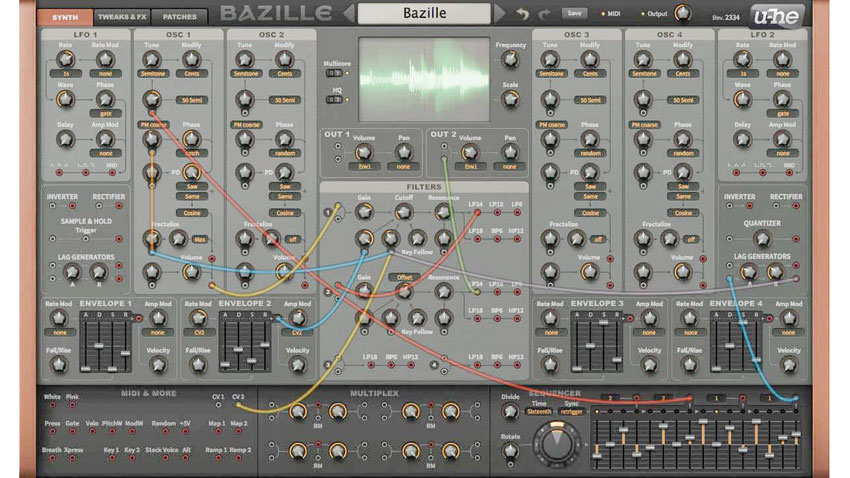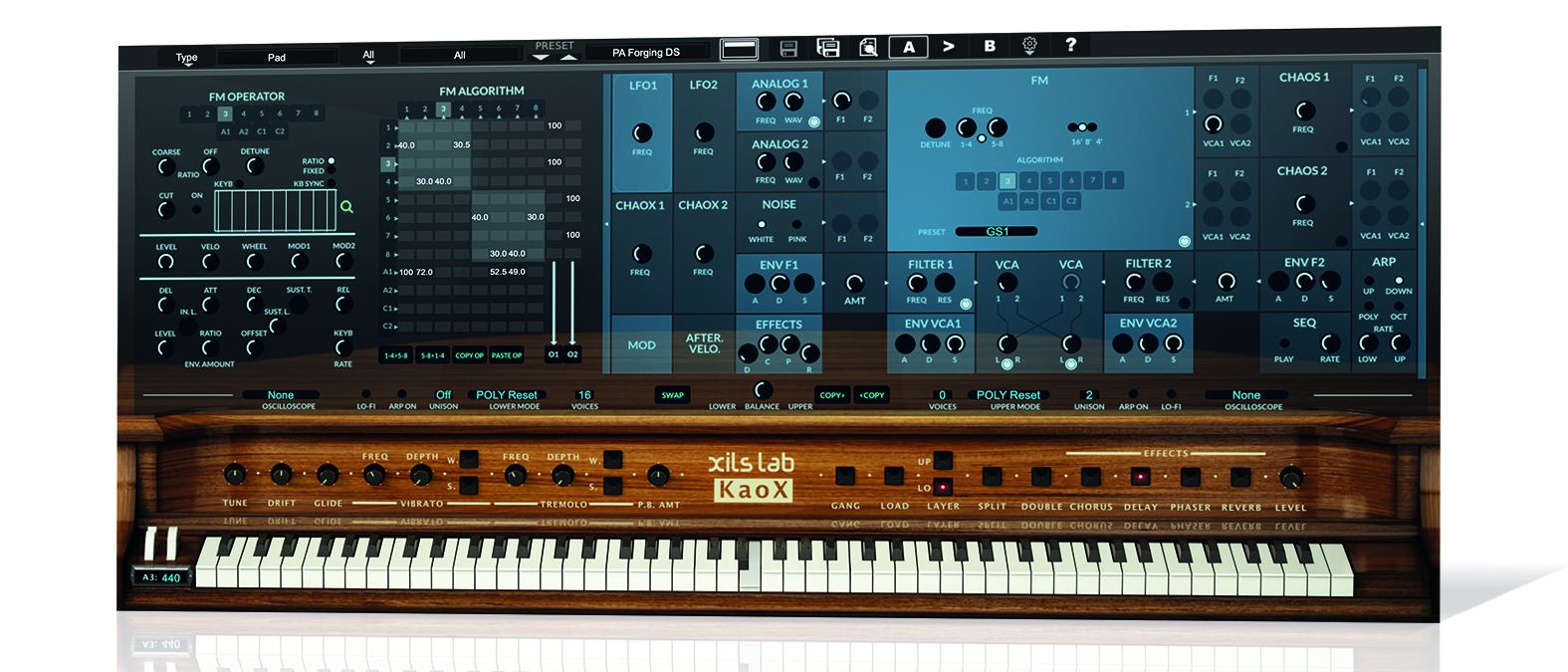MusicRadar Verdict
KaoX produces some wonderfully rich sounds, offering an intriguing hybrid take on FM synthesis.
Pros
- +
Hybrid sound generation.
- +
8-operator FM synthesis.
- +
Easy to use FM modulation matrix.
- +
Excellent rich sounds.
Cons
- -
CPU hungry.
- -
Large plugin window works best on higher resolution screens.
- -
MusicRadar's got your back
XILS-lab KaoX: What is it?
XILS-lab KaoX (VST, AU, AAX) is a hybrid synth that’s based on Yamaha’s rare early 80s FM synth, the GS1. Very few GS1s were made, and most lacked the external programmer so were pretty limited from an editing perspective.
KaoX takes this 8-operator FM concept, makes it easy to edit and then beefs it up with two analogue oscillators, two chaotic oscillators, two analogue filters, two LFOs, two chaotic modulators, two envelopes, two output VCAs with individual output panning, four effects, arpeggiator and step sequencer.
Phew! Significantly, it then duplicates the whole thing into a dual-layer (Lower and Upper) architecture. Powerful stuff.
XILS-lab KaoX: Performance and verdict
KaoX’s default state is a simple view, inspired by the wooden design of the GS1. Here you can set overall performance aspects such as Tune, Glide and Pitchbend and activate the four effects (Chorus, Delay, Phaser and Reverb). You can also choose single or dual-layer playback and load one of the more than 500 presets.
For in-depth editing, you open the large parameter panel at the top, and you can edit layers individually or together (Gang). This is arranged in a clear, modular fashion albeit with a standard signal flow, and active modules are illuminated, which is handy. Some modules such as filters and oscillators include on/off switching and this can help save CPU.
The layout is centred around the five oscillators and noise generator and their connection to the two global VCAs and two global Filters. Some key parameters are instantly available on the modules themselves and clicking on a module provides a detailed view in the left panel. A further foldaway panel to the right provides context-specific help.
From a user standpoint, this isn’t quite as immediate as it could be, but there are no further hidden panels which is a good thing. Either way, KaoX clearly has a lot of parameters to fit in. This makes for a large plugin window and, although adjustable, the most compact window size is pretty fiddly.
Want all the hottest music and gear news, reviews, deals, features and more, direct to your inbox? Sign up here.
Total Chaos
KaoX includes chaotic oscillators and modulators but what does this mean in practice? The chaotic oscillators are designed to mimic real-life behaviours and there are three algorithms - 2M, Chaos and Subh. 2M produces a voice-like sound, Chaos is a type of noise generator and Subh is a chaotic subharmonic.
Each has a Tune option, a Parameter setting that modifies the underlying algorithm, and Keep Pitch, which preserves the pitch when you adjust the Parameter setting. The oscillators provide instant oddness and the rich, eerie sound of 2M is particularly enjoyable.
For chaotic modulation, fire up the two ChaoX LFOs. There’s a choice from four quite individual repetitive cycles, represented on an XY display. Oscillator behaviour is finessed using the smoothing (Glide) and randomness (Amount) sliders. Each oscillator can modulate up to four target parameters, or be used as a source in the Modulation panel.
Big sounds
As mentioned, KaoX includes both chaotic oscillators and analogue oscillators and, for the latter, the Wave knob selects the shape, moving from triangle to saw, then square to pulse. These oscillators considerably expand the sound palette.

• U-he Bazille
Phase distortion, FM and fractal resonance are featured in this flexible modular instrument.
• Native Instruments FM8
Native’s powerful design is the industry standard FM synth.
However, KaoX’s FM synthesis is the star here. Centred around the FM Algorithm matrix, the eight operators are arranged in two banks of four. The matrix provides cross-modulation between operators and also modulation of operators by the analogue and chaos oscillators.
In addition to individual operator pitch, you also have individual control over onward levels to the VCAs and analogue filters. There is a handful of FM operator presets and sonically KaoX’s FM engine can deliver typical FM sounds that are bright, punchy or bell-like.
But it also produces amazingly rich sounds you wouldn’t necessarily associate with FM synthesis. What’s more, with swift access to cross-modulation and easy tailoring via the main VCAs and analogue filters, sound editing is quick and fun.
Nevertheless, this power and complexity requires plenty of CPU. So, when you increase the number of voices per layer (up to 16), fire up the unison, select both layers and start playing chords, things can get a bit sticky. Overall, this is the only big gripe, and KaoX’s bold, ambitious design is impressive.
MusicRadar verdict: KaoX produces some wonderfully rich sounds, offering an intriguing hybrid take on FM synthesis.
XILS-lab KaoX: The web says
"KaoX has interesting features that freshen up the FM topic, especially through the VA and chaotic oscillators and modulator options."
Synth Anatomy
"The time has clearly come to revisit the wonderful world of FM synthesis with a modern-day twist and appreciate the power of KaoX, XILS-lab’s latest virtual instrument par excellence."
MusicPlayers.com
XILS-lab KaoX: Hands-on demos
XILS-lab
Simon Le Grec
XILS-lab KaoX: Specifications
- Software Type: Synth
- Platform: Mac, PC
- Upgrade/Full: Full
- Download/Boxed: Download
- Bit Depth: 32-bit, 64-bit
- Format: AAX Native, VST, AU
- Authorization Type: iLok Account
- Hardware Requirements - Mac: Intel Core 2 Duo or higher, 4GB RAM minimum
- Hardware Requirements - PC: Intel Core 2 Duo / AMD Athlon 64 X2 or higher, 4GB RAM minimum
- OS Requirements - Mac: OS X 10.9.5 or later
- OS Requirements - PC: Windows 7 SP1 or later
- Manufacturer Part Number: 11-31520
- CONTACT: XILS-lab
Computer Music magazine is the world’s best selling publication dedicated solely to making great music with your Mac or PC computer. Each issue it brings its lucky readers the best in cutting-edge tutorials, need-to-know, expert software reviews and even all the tools you actually need to make great music today, courtesy of our legendary CM Plugin Suite.



